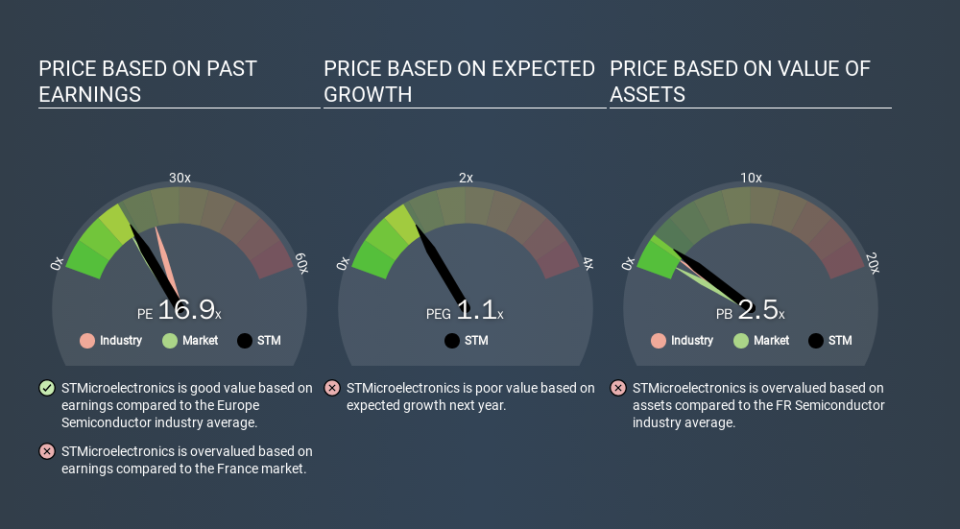How Does STMicroelectronics's (EPA:STM) P/E Compare To Its Industry, After The Share Price Drop?

Unfortunately for some shareholders, the STMicroelectronics (EPA:STM) share price has dived 38% in the last thirty days. Looking back over the last year, the stock has been a solid performer, with a gain of 27%.
All else being equal, a share price drop should make a stock more attractive to potential investors. While the market sentiment towards a stock is very changeable, in the long run, the share price will tend to move in the same direction as earnings per share. The implication here is that long term investors have an opportunity when expectations of a company are too low. One way to gauge market expectations of a stock is to look at its Price to Earnings Ratio (PE Ratio). A high P/E ratio means that investors have a high expectation about future growth, while a low P/E ratio means they have low expectations about future growth.
Check out our latest analysis for STMicroelectronics
How Does STMicroelectronics's P/E Ratio Compare To Its Peers?
We can tell from its P/E ratio of 16.92 that sentiment around STMicroelectronics isn't particularly high. If you look at the image below, you can see STMicroelectronics has a lower P/E than the average (19.6) in the semiconductor industry classification.
Its relatively low P/E ratio indicates that STMicroelectronics shareholders think it will struggle to do as well as other companies in its industry classification. While current expectations are low, the stock could be undervalued if the situation is better than the market assumes. You should delve deeper. I like to check if company insiders have been buying or selling.
How Growth Rates Impact P/E Ratios
Earnings growth rates have a big influence on P/E ratios. When earnings grow, the 'E' increases, over time. That means unless the share price increases, the P/E will reduce in a few years. So while a stock may look expensive based on past earnings, it could be cheap based on future earnings.
STMicroelectronics shrunk earnings per share by 19% over the last year. But EPS is up 52% over the last 5 years.
A Limitation: P/E Ratios Ignore Debt and Cash In The Bank
Don't forget that the P/E ratio considers market capitalization. So it won't reflect the advantage of cash, or disadvantage of debt. Theoretically, a business can improve its earnings (and produce a lower P/E in the future) by investing in growth. That means taking on debt (or spending its cash).
While growth expenditure doesn't always pay off, the point is that it is a good option to have; but one that the P/E ratio ignores.
So What Does STMicroelectronics's Balance Sheet Tell Us?
Since STMicroelectronics holds net cash of US$662m, it can spend on growth, justifying a higher P/E ratio than otherwise.
The Bottom Line On STMicroelectronics's P/E Ratio
STMicroelectronics has a P/E of 16.9. That's higher than the average in its market, which is 14.2. Falling earnings per share is probably keeping traditional value investors away, but the relatively strong balance sheet will allow the company time to invest in growth. Clearly, the high P/E indicates shareholders think it will! Given STMicroelectronics's P/E ratio has declined from 27.1 to 16.9 in the last month, we know for sure that the market is significantly less confident about the business today, than it was back then. For those who don't like to trade against momentum, that could be a warning sign, but a contrarian investor might want to take a closer look.
Investors should be looking to buy stocks that the market is wrong about. If the reality for a company is better than it expects, you can make money by buying and holding for the long term. So this free report on the analyst consensus forecasts could help you make a master move on this stock.
Of course, you might find a fantastic investment by looking at a few good candidates. So take a peek at this free list of companies with modest (or no) debt, trading on a P/E below 20.
If you spot an error that warrants correction, please contact the editor at editorial-team@simplywallst.com. This article by Simply Wall St is general in nature. It does not constitute a recommendation to buy or sell any stock, and does not take account of your objectives, or your financial situation. Simply Wall St has no position in the stocks mentioned.
We aim to bring you long-term focused research analysis driven by fundamental data. Note that our analysis may not factor in the latest price-sensitive company announcements or qualitative material. Thank you for reading.

